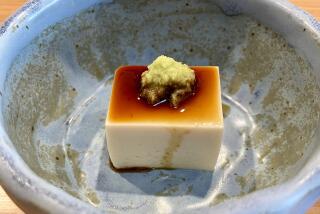The Tricky Art of Making Tofu
- Share via
The kind of old-fashioned nigari tofu that Hiroshi Uyehara turns out at Aloha Grocery is rare, even in Japan. “It’s finicky,” says Uyehara. “If you change the temperature or stir it too long or even have the wrong kind of beans, it won’t work.” Because it is coagulated with an extract of sea water, rather than the more modern calcium sulfate, it won’t firm up unless conditions are exactly right.
To be sure everything is ideal, Uyehara arrives at Aloha’s tofu plant by 6:30 a.m. ready to work in his rubber boots and apron. The 67-year-old tofu master was trained in Japan by one of the country’s few remaining nigari producers. And in a culture whose chefs and artisans are notoriously secretive about their skills, convincing the master to reveal his techniques was no mean feat. But Uyehara has always been a determined man.
With automated factories spewing out thousands of pounds of tofu a day for the Los Angeles market, he resolved to keep making the kind of flavorful tofus that must be produced in small batches. With the same determination, he went into business after World War II as a grocery peddler in Hawaii, selling foods from a truck. Eventually Uyehara parlayed the venture into a thriving Japanese market in West Los Angeles. And when the supermarkets in Aloha’s neighborhood cut into his business by stocking Japanese groceries, he began to compete by setting up West Los Angeles’ only fresh tofu shop, selling several varieties known previously only in Japan.
To find out everything he could about tofu production, Uyehara traveled to Japan. And after perfecting his nigari tofu in Tokyo, he went to Nagoya to learn about soy milk. Then in Kyoto, Uyehara mastered the kind of silken tofu that keeps its velvety custard-like texture yet won’t fall apart when picked up with chop sticks. There, he also discovered a wonderfully fresh-tasting yuzu tofu, flavored with Japanese lime, and another version with roasted sesame paste mixed into it.
At Aloha, Uyehara also set up a kitchen like the ones in the shops he had visited. Now the store produces deep-fried tofu cutlets, tofu pouches to stuff and other prepared tofu items. Cooked in small batches, these are less oily and have a superior texture than their mass-produced counterparts.
More to Read
Eat your way across L.A.
Get our weekly Tasting Notes newsletter for reviews, news and more.
You may occasionally receive promotional content from the Los Angeles Times.










